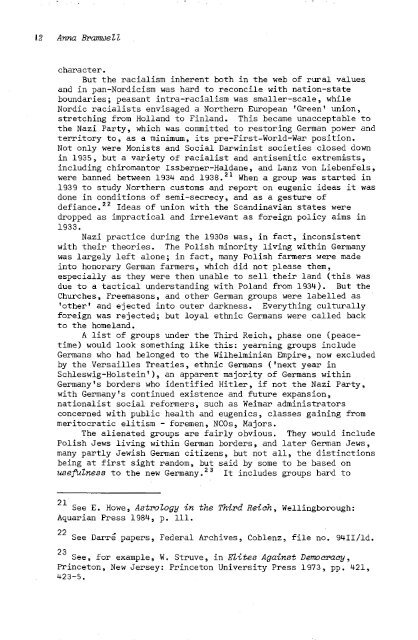Download searchable PDF of Volume 16 1985 - Institute of Social ...
Download searchable PDF of Volume 16 1985 - Institute of Social ...
Download searchable PDF of Volume 16 1985 - Institute of Social ...
You also want an ePaper? Increase the reach of your titles
YUMPU automatically turns print PDFs into web optimized ePapers that Google loves.
12 Anna BT'Gmwe 1, l<br />
character.<br />
But the r.acialism inherent both in the web <strong>of</strong> rural values<br />
and in pan-Nordicism was hard to reconcile with nation-state<br />
boundaries; peasant intra-racialism was smaller-scale, while<br />
Nordic racialists envisaged a Northern European 'Green' union,<br />
stretching from Holland to Finland. This became unacceptable to<br />
the Nazi Party, which was committed to restoring German power and<br />
territory to, as a minimum, its pre-First-World-War position.<br />
Not only were Monists and <strong>Social</strong> Darwinist societies closed down<br />
in 1935, but a variety <strong>of</strong> racialist and antisemitic extremists,<br />
including chiromantor Issberner-Haldane, and Lanz von Liebenfels,<br />
were banned between 1934 and 1938. 21 When a group was started in<br />
1939 to study Northern customs and report on eugenic ideas it was<br />
done in conditions <strong>of</strong> semi-secrecy, and as a gesture <strong>of</strong><br />
defiance. 22 Ideas <strong>of</strong> union with the Scandinavian states were<br />
dropped as impractical and irrelevant as foreign policy aims in<br />
1933.<br />
Nazi practice during the 1930s was, in fact, inconsistent<br />
with their theories. The Polish minority living within Germany<br />
was largely left alone; in fact, many Polish farmers were made<br />
into honorary German farmers, which did not please them,<br />
especially as they were then unable to sell their land (this was<br />
due to a tactical understanding with Poland from 1934). But the<br />
Churches, Freemasons, and other German groups were labelled as<br />
'other' and ejected into outer darkness. Everything culturally<br />
foreign was rejected; but loyal ethnic Germans were called back<br />
to the homeland.<br />
A list <strong>of</strong> groups under the Third Reich, phase one (peacetime)<br />
would look something like this: yearning groups include<br />
Germans who had belonged to the Wilhelminian Empire, now excluded<br />
by the Versailles Treaties, ethnic Germans ('next year in<br />
Schleswig-Holstein'), an apparent majority <strong>of</strong> Germans within<br />
Germany's borders who identified Hitler, if not the Nazi Party,<br />
with Germany's continued existence and future expansion,<br />
nationalist social reformers, such as Weimar administrators<br />
concerned with public health and eugenics, classes gaining from<br />
meritocratic elitism - foremen, NCOs, Majors.<br />
The alienated groups are fairly obvious. They would include<br />
Polish Jews living within German borders, and later German Jews,<br />
many partly Jewish German citizens, but not all, the distinctions<br />
being at first sight random, but said by some to be based on<br />
usefulness to the new Germany.23 It includes groups hard to<br />
21 See E. Howe, Astrology in the Third Reiah, Wellingborough:<br />
Aquarian Press 1984, p. Ill.<br />
22 See Darre papers, Federal Archives, Coblenz, file no. 94II/ld.<br />
23 See, for example, W. Struve, in Elites Against Demoaraay,<br />
Princeton, New Jersey: Princeton University Press 1973, pp. 421,<br />
423-5.
















